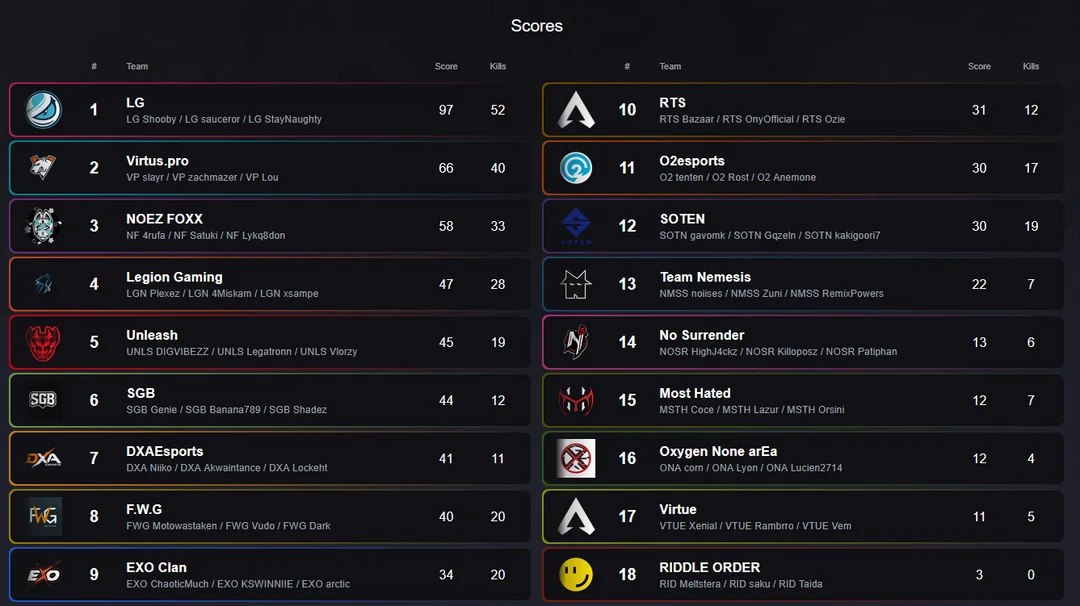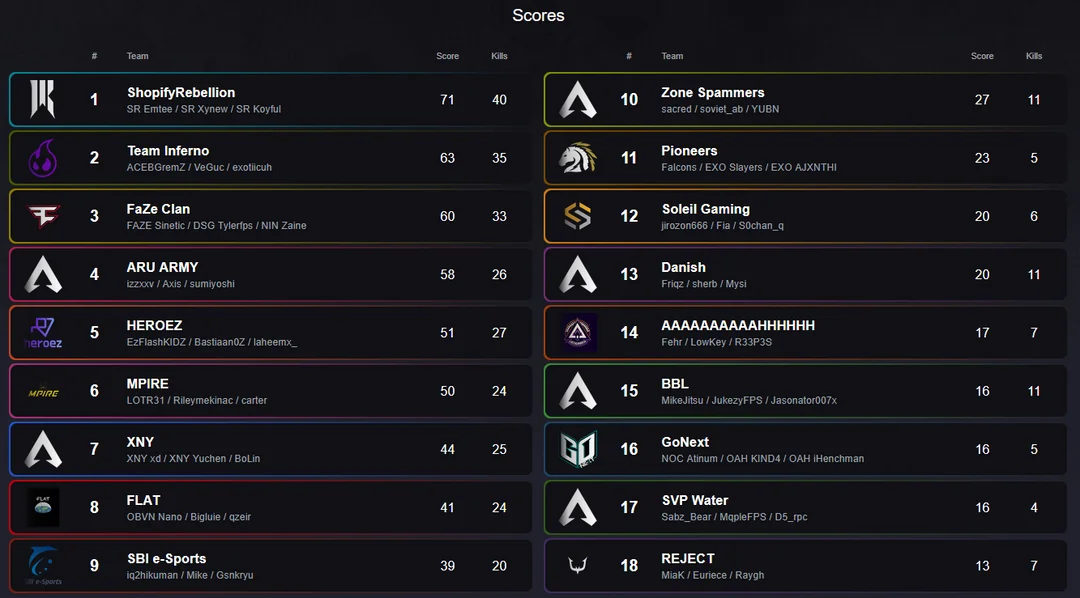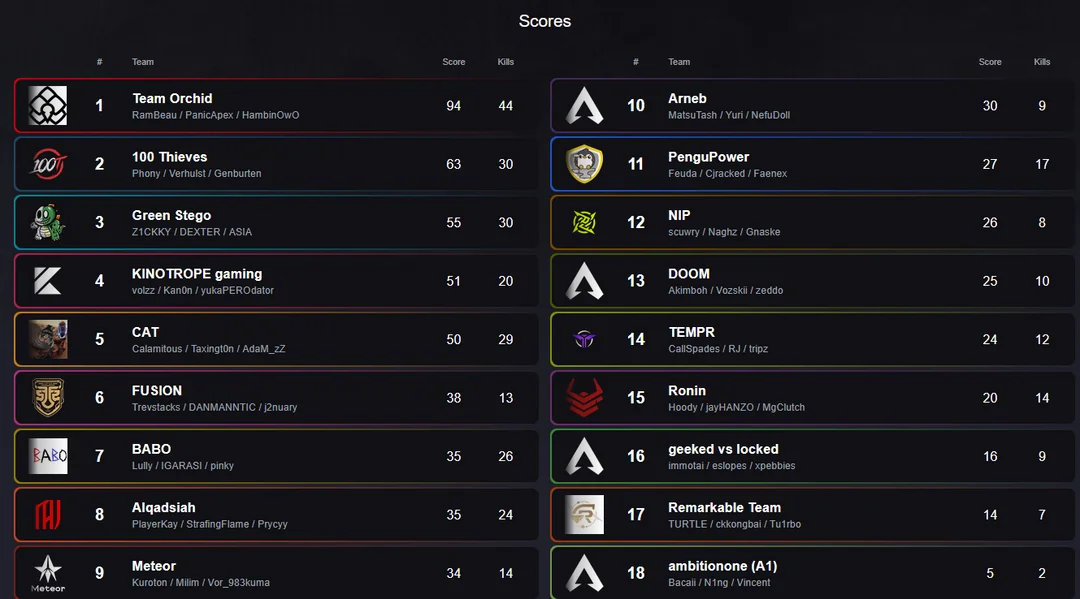ALGS Open LAN Day 1: Everything You Need to Know

Key Takeaways
- 160 teams competed in the largest Apex tournament ever in New Orleans
- Double-elimination format with Winners and Elimination rounds
- Falcon (with ImperialHal) dominated with 99 points in their lobby
- Luminosity Gaming won three consecutive games in their lobby
- Legend meta shifted dramatically between rounds with Newcastle and Crypto popular in Round 1
- Top teams advance to Day 2 while bottom teams were eliminated on Day 1
- Maps in rotation: World's Edge and E-District with POI Drafts and Legend Bans
Tournament Format: The Biggest Apex Event Ever
The ALGS Open LAN kicked off on May 1, 2025, with an absolutely massive 160 teams competing at the Ernest N. Morial Convention Center in New Orleans. I gotta say, this is easily the biggest Apex tournament we've ever seen, and the format was pretty interesting.
They're using a double-elimination bracket that's meant to narrow down to just 20 teams for the Grand Finals. Day One had Winners Rounds 1 and 2, plus Elimination Round 1. The stakes were super high right from the start!
All teams started in the Winners Bracket and were split into 8 lobbies for Round 1. The top ten teams from each lobby moved on to the next Winners Round, while the bottom ten dropped to the Elimination bracket. In the Elimination bracket, teams faced a do-or-die situation – finish in the top ten to stay alive, or pack your bags.
The maps they played were World's Edge and E-District, and they used POI Drafts and Legend Bans to mix things up. This format created some crazy intense moments right from day one, with teams fighting for their tournament lives hours after it started.
For players looking to improve their own ranked games, these tournament strategies can provide valuable insights. Many of these pro techniques can be applied to your own games with services like Apex Boosting that help you understand high-level play.
Winners Round 1: The Opening Battles
The first round delivered some amazing gameplay across all lobbies. Here's what happened in each:

In Lobby 1, Luminosity Gaming went absolutely crazy with 97 points, winning three games in a row. That's something you almost never see at this level of competition! Their rotations were perfect, and their teamfights were clean.

Lobby 2 saw SR take first with 71 points. They weren't as flashy as some of the other lobby winners, but their consistency was impressive.

The biggest story from Lobby 3 was Falcon, featuring the legendary ImperialHal. They racked up 99 points to take first place. During one amazing sequence, they wiped multiple teams back-to-back, taking out WLG, Nemesis, and CIMJ in quick succession.

T-Orcid topped Lobby 4 with 94 points, showing that the competitive scene is more open than ever with some less-known teams performing at the highest level.
The other lobbies were just as exciting:
- Lobby 5: FURIA showed up big time with 98 points
- Lobby 6: Eternal grabbed the win with 72 points
- Lobby 7: ESM finished first with 73 points
- Lobby 8: Alliance took the top spot with 64 points
Alliance's performance was especially cool because they got their points through super consistent placements across all six games. No huge pop-off games, just solid play throughout.
Winners Round 2: Turning Up the Heat
As the day went on, the competition in Winners Round 2 got even more intense. Only the best teams from Round 1 made it here, and you could tell the level of play was way higher.
In Winners Round 2 Group 3, Twerkaholics (yes, that's their real name!) were the stars of the show. They scored 83 points in six games with multiple high-elimination performances. Their aggressive but smart approach worked amazingly well.
Behind them, Natus Vincere got second with 56 points, and FURIA continued their strong day with a third-place finish at 51 points. Other teams that did great were YungBlackRicky (50 points), NRG (49 points), and S8UL (49 points).
The gameplay was noticeably different in Round 2. Teams that had been feeling each other out in Round 1 now knew exactly what they were up against. Rotations became more contested, and early fights were more common as teams fought for the best positions.
Players looking to climb the ranked ladder can learn a lot from these pro strategies. Services like Rank Boosting can help you understand and implement these high-level tactics in your own games.
Elimination Round: Fighting for Survival
The Elimination bracket was where things got really desperate. Teams that didn't do well in Winners Round 1 had to fight for their tournament lives, and you could feel the pressure in how they played.
Teams that normally play safe were taking more risks. Early rotations turned into fights, and teams were contesting POIs they'd normally avoid. It was win or go home, and nobody wanted to go home on day one.
While we don't have complete results for all Elimination Round lobbies, the partial info from Lobbies 3 and 4 showed just how intense these games were. Teams were using way more aggressive strategies, knowing that playing it safe probably wouldn't be enough to advance.
Some teams completely changed their drop spots and legend compositions, showing that adaptation is key to survival in this format. The elimination bracket also saw some of the highest elimination counts of the day, with teams taking every fight they could to rack up points.
Legend Meta: The Characters Behind the Players
One of the most interesting things about day one was seeing how the legend meta evolved even within just one day of competition.
In Winners Round 1, the most picked legends were:
- Newcastle (44.74%)
- Crypto (43.86%)
- Fuse (39.47%)
- Ballistic (30.7%)
- Bangalore (26.32%)
But by Winners Round 2, things had already changed:
- Catalyst (46.67%)
- Ash (39.17%)
- Alter (33.33%)
- Fuse (28.33%)
- Wattson (23.33%)
This quick shift shows how teams were adapting on the fly based on what was working. Wattson, for example, didn't see much play in Round 1 but jumped up to a 23.33% pick rate in Round 2. She also had an impressive 10.7% win rate and great top 5 placement stats, showing that teams were finding success with her.
The meta shift wasn't random - teams were watching what worked in earlier games and copying it. Newcastle's defensive capabilities were valued early, but as teams got more aggressive, legends like Ash and Catalyst became more popular for their offensive potential and zone control.
Team Spotlight: Day 1 Standouts
Several teams had performances that deserve special attention from day one:
-
Falcon (with ImperialHal): Their 99-point lobby win in Winners Round 1 was masterful. During one sequence, they systematically took down multiple teams in a row, earning tons of elimination points. ImperialHal's shotcalling was on point, and their positioning was perfect throughout.
-
Luminosity Gaming: Winning three consecutive games in their lobby is almost unheard of at this level. Their coordination was flawless, and they seemed to always be one step ahead of the competition in terms of rotations and zone predictions.
-
Gaming Gladiators: They closed out their round with a massive 24-point game that included double-digit eliminations. This kind of explosive scoring potential makes them a team to watch as the tournament continues.
-
Twerkaholics: Their dominant 83-point performance in Winners Round 2 Group 3 showed they can compete with the very best teams in the world. Their aggressive playstyle paid off big time, and they'll be a threat going forward.
-
Alliance: Their incredibly consistent performance across all six games in their lobby shows a different but equally effective approach. While other teams had big highs and lows, Alliance kept putting up good numbers game after game.
These standout teams showed different paths to success. Some relied on aggressive plays and high elimination counts, while others prioritized consistent placements and smart rotations. Both approaches worked on day one, and it'll be fascinating to see which strategy prevails as the tournament continues.
Viewership and Global Impact
The event pulled in decent numbers for day one, with around 42,000 concurrent viewers across Twitch, YouTube, and FACEIT. That's pretty good for an opening day!
What's really cool is how international the audience was. Japanese, Indian, Russian, and Chinese viewers made up a big chunk of the viewership, especially on FACEIT where numbers reportedly hit 30,000 at times. This global audience shows just how popular Apex Legends esports has become worldwide.
The FACEIT Watch feature, which let viewers follow up to four team POVs at once, was a hit with hardcore fans. Being able to watch your favorite team's perspective throughout a match adds a whole new dimension to the viewing experience.
What's Next for ALGS Open LAN
With day one in the books, attention turns to the upcoming days of competition. The tournament will continue to narrow down the field, with more teams being eliminated and the competition getting even more intense.
Teams that advanced through Winners Rounds 1 and 2 are in a good position, but they can't get complacent. The format is unforgiving, and one bad day can send even a top team home early.
For teams in the Elimination bracket, the pressure only increases. They've survived day one, but they have no room for error going forward. Every game is do-or-die, which should make for some incredibly tense and exciting matches.
As the tournament progresses, expect to see the meta continue to evolve as teams figure out what works best in this environment. The legend picks, drop spots, and rotation strategies that emerged on day one will be refined and countered as teams adapt to each other.
Frequently Asked Questions
How many teams competed in the ALGS Open LAN?
A total of 160 teams competed in the ALGS Open LAN, making it the largest Apex Legends tournament ever organized.
What is the format of the ALGS Open LAN?
The tournament uses a double-elimination bracket format. All teams start in the Winners Bracket, with the bottom teams from each round dropping to the Elimination bracket. The tournament will identify the top 20 teams that will advance to the Grand Finals.
Which team had the highest score on Day 1?
Falcon, featuring ImperialHal, had the highest score with 99 points in Winners Round 1 Lobby 3.
What maps are being played in the tournament?
The maps in rotation are World's Edge and E-District.
What legends were most popular on Day 1?
In Winners Round 1, the most popular legends were Newcastle (44.74%), Crypto (43.86%), and Fuse (39.47%). By Winners Round 2, the meta shifted to Catalyst (46.67%), Ash (39.17%), and Alter (33.33%).
How many teams were eliminated on Day 1?
While exact numbers weren't provided in the source information, approximately 80 teams (half of the 160 total) were at risk of elimination after Winners Round 1, with the bottom teams from each Elimination Round lobby being eliminated.
Where can I watch the ALGS Open LAN?
The event is broadcast on the official PlayApex channels on both Twitch and YouTube, with additional coverage in multiple languages. FACEIT Watch also offers the ability to follow up to four team POVs simultaneously.
How can I improve my own Apex Legends gameplay based on what the pros are doing?
Studying pro strategies from tournaments like ALGS can help improve your own gameplay. Services like Apex Boosting can help you implement professional strategies in your ranked games.